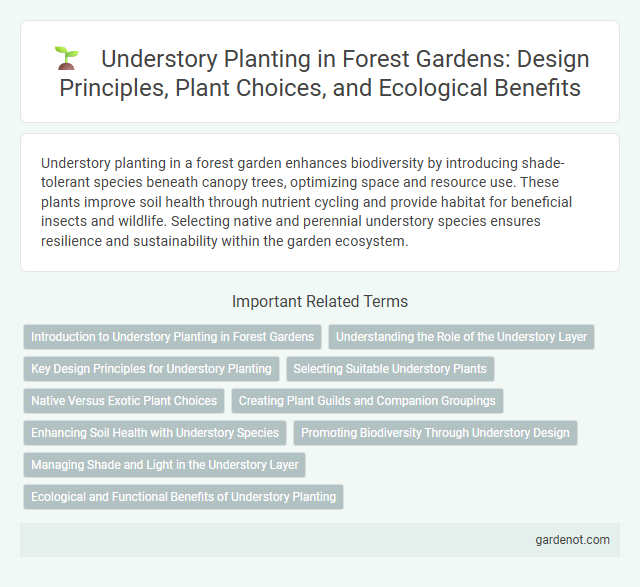Understory planting in a forest garden enhances biodiversity by introducing shade-tolerant species beneath canopy trees, optimizing space and resource use. These plants improve soil health through nutrient cycling and provide habitat for beneficial insects and wildlife. Selecting native and perennial understory species ensures resilience and sustainability within the garden ecosystem.
Introduction to Understory Planting in Forest Gardens
Understory planting in forest gardens involves cultivating shade-tolerant plants beneath the canopy layer, maximizing vertical space and biodiversity. This technique enhances ecosystem functions by supporting soil health, improving microclimates, and providing habitat for beneficial insects and wildlife. Selecting native, shade-loving species such as ferns, herbaceous perennials, and low-growing shrubs ensures sustainable growth and complements the forest garden's structure.
Understanding the Role of the Understory Layer
The understory layer in a forest garden plays a crucial role in enhancing biodiversity, improving soil health, and providing habitat for beneficial insects and wildlife. Understory planting includes shade-tolerant species such as herbs, shrubs, and small trees that thrive beneath the canopy, helping to retain moisture and suppress weed growth. Integrating diverse understory plants promotes ecological balance and supports the overall resilience of the forest garden ecosystem.
Key Design Principles for Understory Planting
Understory planting in forest gardens emphasizes selecting shade-tolerant species that complement the upper canopy layers, ensuring biodiversity and resource efficiency. Key design principles include layering plants by height and root depth to minimize competition, incorporating nitrogen-fixing species to enhance soil fertility, and choosing perennials that provide habitat and food for pollinators. Proper spatial arrangement supports microclimate regulation and maximizes photosynthesis in low-light conditions, promoting a resilient ecosystem.
Selecting Suitable Understory Plants
Selecting suitable understory plants for a forest garden involves choosing shade-tolerant species that thrive beneath canopy layers, such as ferns, shade-loving herbs like wild ginger, and nitrogen-fixing shrubs like American hazelnut. These plants contribute to soil health, biodiversity, and provide edible or medicinal yields, supporting the overall ecosystem. Effective understory planting enhances forest garden resilience by maximizing vertical space and promoting natural pest control.
Native Versus Exotic Plant Choices
Understory planting in forest gardens benefits from prioritizing native species, which support local biodiversity by providing habitat and food for indigenous wildlife. Native plants typically require less maintenance and are better adapted to local soil, climate, and pest conditions, ensuring sustainable growth and ecosystem balance. In contrast, exotic species may introduce invasive traits, disrupt ecological relationships, and increase the need for chemical inputs, undermining the garden's health and resilience.
Creating Plant Guilds and Companion Groupings
Understory planting in forest gardens enhances biodiversity by introducing shade-tolerant species that complement canopy trees, fostering resilient plant guilds. Strategic companion groupings maximize nutrient cycling, pest control, and microclimate regulation, promoting sustainable ecosystem functions. Integrating nitrogen-fixing plants, dynamic accumulators, and pollinator attractors within guilds optimizes growth and yield in diverse multilayered agroforestry systems.
Enhancing Soil Health with Understory Species
Understory planting in forest gardens significantly enhances soil health by introducing nitrogen-fixing species such as clover and lupines, which naturally enrich the soil with essential nutrients. Deep-rooted understory plants like comfrey and dandelion improve soil structure and promote beneficial microbial activity by breaking up compacted layers and cycling nutrients. These diverse understory species create a multilayered ecosystem that supports nutrient retention, moisture conservation, and long-term soil fertility.
Promoting Biodiversity Through Understory Design
Understory planting in forest gardens enhances biodiversity by creating layered habitats that support a wide range of flora and fauna, including shade-tolerant plants, insects, and small wildlife. Selecting native species like ferns, shrubs, and groundcovers fosters ecological balance and encourages pollinator activity, which boosts ecosystem resilience. Designing diverse understory layers improves soil health and nutrient cycling, making forest gardens more productive and sustainable.
Managing Shade and Light in the Understory Layer
Understory planting in forest gardens requires careful management of shade and light to optimize plant growth and biodiversity. Selecting shade-tolerant species such as ferns, shade-adapted herbs, and small shrubs ensures a productive understory that thrives beneath taller canopy trees. Monitoring light levels and pruning canopy branches promotes adequate sunlight penetration, balancing microclimate conditions essential for understory plant health and ecosystem stability.
Ecological and Functional Benefits of Understory Planting
Understory planting in forest gardens enhances biodiversity by providing habitat and food sources for various pollinators, birds, and beneficial insects, which contributes to ecosystem stability. These plants improve soil health through nitrogen fixation and organic matter accumulation, fostering nutrient cycling and moisture retention. Functionally, understory vegetation suppresses weeds, reduces erosion, and creates microclimates that support the growth of overstory crops while increasing overall forest productivity.
Understory planting Infographic

 gardenot.com
gardenot.com